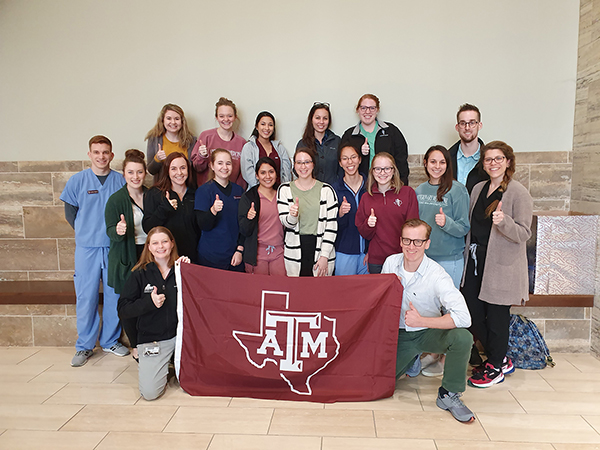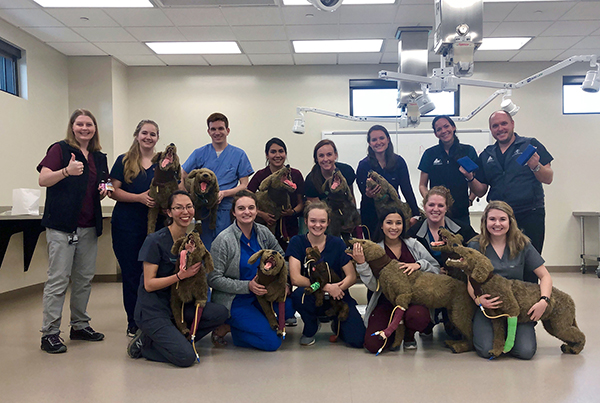CVM Student Organization Hosts Unique CPR Training for Students, Faculty
Story by Megan Myers, CVMBS Communications

The Texas A&M College of Veterinary Medicine & Biomedical Sciences (CVM) has become one of the first colleges in the country to provide students and faculty with both basic and advanced CPR training under the Reassessment Campaign on Veterinary Resuscitation (RECOVER) initiative.
The RECOVER initiative, the first standardized CPR training to offer certification through the American College of Veterinary Emergency and Critical Care (ACVECC), was created in 2010 with the goal of developing and disseminating the first true evidence-based veterinary cardiopulmonary resuscitation (CPR) guidelines.
The CVM chapter of the Student Veterinary Emergency and Critical Care Society (SVECCS) hosted a RECOVER CPR certification training on Jan. 18 to provide an opportunity for veterinarians and veterinary students to further their training on CPR techniques.
“Here at A&M, we offer both CPR certification levels, which is a really unique opportunity,” said Dr. Christine Rutter, a clinical assistant professor and SVECCS faculty adviser. “We’re one of only a few places in the country that are able to use interactive simulators for the advanced class.”
The RECOVER CPR training consists of online modules, videos, and quizzes, followed by a six-hour day of hands-on practice with CPR simulators known as “Jerry” dogs.
“You really learn the physiology behind CPR, as well as how you can use that physiology to better adapt your technique or your strategies (for resuscitating an animal),” said Katie Freeman, a second-year veterinary student and SVECCS treasurer. “It was very one-on-one. The instructors were always there giving critiques or feedback.”
Besides the physical motions of CPR, the training also focused on the communication skills that are necessary to help maintain order in emergency situations.
“As a student, being able to lead a team and learn how to actually walk through the steps and come across as appropriate and professional, but also get done what needs to get done, was one of the coolest things that I learned and why I think this course was so vital,” Freeman said.

Two veterinarians from the Texas A&M Veterinary Medical Teaching Hospital (VMTH) and 22 veterinary students attended the training, which will be offered again at multiple conferences at the CVM this year.
While the RECOVER CPR training is not yet offered to the general public, Rutter hopes that it will become an option in the future.
“The hospital members who learn can teach everybody at the Small Animal Hospital, and then when we go off as veterinarians, we can teach our technicians,” said Alyssa Gentry, a third-year veterinary student and SVECCS president. “It really spreads all the knowledge and raises the standard of care, as far as CPR goes.”
Though CPR is often portrayed in movies and TV shows as being successful nearly every time, it is typically only effective 50 percent of the time for animal patients under anesthesia and 5 percent or less for patients not under anesthesia.
“With these techniques we’ve been learning, our hope is to raise those numbers,” Freeman said. “Across the board, everybody is going to experience an emergency case and should be equipped to perform CPR. Emergencies can happen at any time of the day, at any point in your career. It’s better to be prepared.”
“There’s so much of veterinary medicine that’s hard for practitioners, for owners, and for the animals,” said Lauren Minner, a second-year veterinary student and SVECCS education coordinator. “CPR really is a thing where you can perform a miracle if you have your stuff together.”
The RECOVER training also gives veterinary students the opportunity to build upon and practice the CPR training they receive as part of the CVM’s Doctor of Veterinary Medicine (DVM) curriculum before they enter the VMTH for their fourth-year clinical rotations.
“The training these students have had is going to really help them when they come to clinics because the biggest thing I see whenever students see their first code (when a patient enters cardiac arrest) is that it’s a traumatic place to be,” Rutter said. “Rather than having a group of students who kind of stand against the wall and watch, these students have already been in these simulated environments.
“If you do a good job in the right situation, there’s a chance you can get that pet home, which is a miracle for that pet and that owner,” Rutter said. “That’s really what we’re all looking for. For the ones you can save, it means everything to that pet and that family.”
###
For more information about the Texas A&M College of Veterinary Medicine & Biomedical Sciences, please visit our website at vetmed.tamu.edu or join us on Facebook, Instagram, and Twitter.
Contact Information: Jennifer Gauntt, Director of Communications, Texas A&M College of Veterinary Medicine & Biomedical Sciences; jgauntt@cvm.tamu.edu; 979-862-4216


